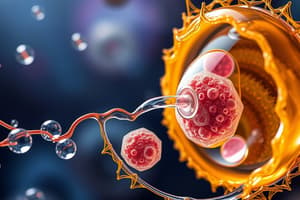Podcast
Questions and Answers
What is the primary function of the Na+-K+ pump?
What is the primary function of the Na+-K+ pump?
- Transport glucose into the cell
- Assist in exocytosis
- Facilitate osmosis
- Maintain the electric gradient by pumping Na+ out and K+ in (correct)
An isotonic solution has an osmolarity higher than 300 mOsm/l.
An isotonic solution has an osmolarity higher than 300 mOsm/l.
False (B)
Define phagocytosis.
Define phagocytosis.
It is the uptake of large particles or bacteria by cells, commonly performed by leukocytes.
The delivery of free energy for active transport comes from _____.
The delivery of free energy for active transport comes from _____.
Match the types of active transport with their definitions:
Match the types of active transport with their definitions:
Which of the following describes facilitated diffusion?
Which of the following describes facilitated diffusion?
How many Na+ ions does the Na+-K+ pump transport out of the cell per cycle?
How many Na+ ions does the Na+-K+ pump transport out of the cell per cycle?
Osmosis only involves the movement of solutes.
Osmosis only involves the movement of solutes.
What is the primary driver for filtration?
What is the primary driver for filtration?
Osmotic fragility refers to the resistance of red blood cells to hemolysis in hypotonic solutions.
Osmotic fragility refers to the resistance of red blood cells to hemolysis in hypotonic solutions.
What is the normal resting membrane potential (RMP) of a typical cell?
What is the normal resting membrane potential (RMP) of a typical cell?
The protein channels that selectively allow ions to pass are known as ______ channels.
The protein channels that selectively allow ions to pass are known as ______ channels.
Match the type of transport with its characteristic:
Match the type of transport with its characteristic:
What is the main factor affecting the rate of simple diffusion?
What is the main factor affecting the rate of simple diffusion?
Ligand-gated protein channels open when a hormone binds to them.
Ligand-gated protein channels open when a hormone binds to them.
Name one example of active transport mechanisms in cells.
Name one example of active transport mechanisms in cells.
What type of transport mechanism across the cell membrane does not require energy?
What type of transport mechanism across the cell membrane does not require energy?
The surface membrane of a cell is primarily composed of a phospholipid bilayer.
The surface membrane of a cell is primarily composed of a phospholipid bilayer.
What is the primary role of the semipermeability of the cell membrane?
What is the primary role of the semipermeability of the cell membrane?
______ refers to the electrical potential difference across the cell membrane during rest.
______ refers to the electrical potential difference across the cell membrane during rest.
Match the following mechanisms with their description:
Match the following mechanisms with their description:
Which of the following is NOT a typical sign of a living cell?
Which of the following is NOT a typical sign of a living cell?
Cholesterol is an essential component of the cell membrane, comprising about 5% of its composition.
Cholesterol is an essential component of the cell membrane, comprising about 5% of its composition.
What is one of the effects of radiation in medicine?
What is one of the effects of radiation in medicine?
Flashcards are hidden until you start studying
Study Notes
Osmosis and Solutions
- Water naturally moves to dilute more concentrated solutions, as per Van Hoff's Law.
- Normal osmolarity: 300 mOsm/L is isotonic, equivalent to 0.9% NaCl or 5% glucose.
- Hypotonic solutions have osmolarity below 0.9%, while hypertonic solutions exceed 0.9%.
- Red blood cells (RBCs) can experience osmotic fragility, leading to hemolysis when exposed to different osmotic conditions.
Active Membrane Transport
- Active transport enables molecule movement against concentration or electric gradients, requiring ATP energy.
- Primary active transport involves selective ion channels, such as the Na⁺-K⁺ pump, Ca²⁺-pump (in muscle cells), and H⁺ proton pump (in stomach cells).
- Secondary active transport uses a carrier mechanism where substances (like glucose) bind to ions (e.g., Na⁺) for membrane transport.
- Exocytosis releases molecules from cells, while endocytosis (including phagocytosis) allows uptake of larger molecules.
Na⁺-K⁺ Pump
- Na⁺-K⁺ pump (Na⁺-K⁺ ATP-ase) is located in the cell membrane and actively transports ions.
- It moves 3 Na⁺ ions out and 2 K⁺ ions into the cell, vital for maintaining electric charge renewal across body cells.
- The pump operates at a maximum capacity of 200 Na⁺ and 133 K⁺ ions per second and necessitates ATP for function.
Resting Membrane Potential (RMP)
- RMP measures the electrical difference between the positively charged extracellular space and the negatively charged intracellular space.
- The negative value results from selective permeability to K⁺, Na⁺, and Cl⁻ ions, influenced by their equilibrium potentials.
Overview of Medical Biophysics
- Medical biophysics integrates various medical sciences, addressing biological problems from atomic to organ levels.
- It provides insights into radiation effects, safety guidelines, and new diagnostic or treatment methods.
Human Cell Characteristics
- Cells are the fundamental units of the body, totaling approximately 60 trillion, varying in size from 4 to 120 µm.
- Key features include metabolism, excitability, and reproduction, organized into tissues forming organs.
Surface Membrane (SM)
- The surface membrane includes intracellular SM and plasmatic SM, providing functions such as semipermeability and protection.
- Composed of a phospholipid bilayer (45% hydrophilic heads, 45% hydrophobic tails) and proteins (50%), it facilitates ion transport and charge storage.
Membrane Transport Mechanisms
- Transport mechanisms are crucial for solute movement, impacting cell metabolism and membrane potentials.
- Passive transport includes diffusion (simple and facilitated) and osmosis, while active transport mechanisms require ATP.
Types of Diffusion
- Simple Diffusion: Passive transport of solutes from high to low concentration until equilibrium is reached. Influenced by concentration gradient, solubility, and temperature.
- Facilitated Diffusion: Involves transport proteins that assist larger molecules across the membrane, changing conformation during the process.
- Ion Channel Diffusion: Passive transport of ions like Na⁺ and K⁺ through selective protein channels, regulated by voltage or ligand binding.
Filtration
- Filtration is the passive movement of water and small particles driven by hydrostatic pressure gradients, distinct from concentration gradients, often seen in capillary actions.
Osmosis
- Osmosis is the passive movement of water through semipermeable membranes, moving from lower to higher osmotic pressure until equilibrium is established.
Studying That Suits You
Use AI to generate personalized quizzes and flashcards to suit your learning preferences.




